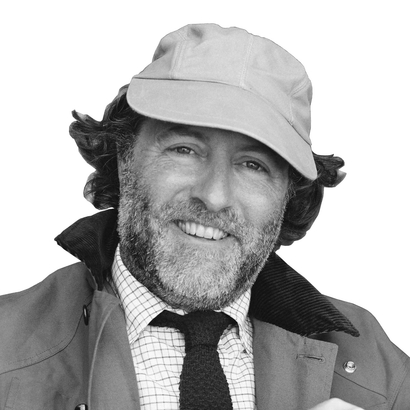Brendan McCarthy has been many things: bartender, photographer, reality-television star, and Argentinean grill–maker. But for the last 29 years, his real job has been guiding fly anglers in Queens’s Jamaica Bay—without a guide, most people wouldn’t know that you can fish right next to J.F.K. Airport—and around the eastern end of Long Island.
With McCarthy’s expertise and some luck, there’s a good chance you’ll catch a striped bass or a coveted false-albacore tuna from the deck of the 23-foot, center-console boat while he looks on with approval. The relationship between a guide and his sport is a complicated one: He’s part expert and part armchair psychologist but also the employee of very wealthy clients. His fee is $800 a day, plus tip.

If you’ve met McCarthy, you probably remember him. When most people are enjoying their first coffee of the day, he’s smoking an American Spirit. He has an easy manner, salt-and-pepper stubble, and a raffish charm. It’s no surprise that he was once an aspiring actor. In the 1990s he lived in Chelsea.
“I was a club kid, wearing black all the time, going to acting classes,” he recalls. He appeared in some commercials. “I worked on a movie with Ray Liotta called Turbulence, which was terrible,” he says. “I may have been edited out of it.”
While he was bartending at Balthazar, McCarthy was also pursuing trout in the mountain waters of the Catskills. But he maintained an affinity for salt water, having grown up in Boston and sailed off Rhode Island as a boy. It was Jon Fisher, the owner of Urban Angler, the renowned shop on Fifth Avenue, who turned him on to striper-fishing.
Striped bass signal the seasons. They swim north from the Chesapeake Bay in the spring and return to the South in the fall. The easiest way to catch one is to fling bait using a conventional rod and reel. The artful way is to cast a fly rod with, say, a Clouser Minnow—a shimmery artificial fly that’s retrieved under the water’s surface—tied to the end. If you associate fly-fishing with silently wading the chalk streams of England in tweed and cords, striper-fishing offers a bracing counterpoint. Instead of the intimacy of wading a stream, saltwater fishing provides an endless backdrop of possibility. McCarthy is always ready to speed to another, hopefully luckier, spot.
You look for birds crashing into the water, eating schools of baitfish. The striped bass are doing the same thing, but from below. Boats arrive at speed, cut their motors, and drift toward the mayhem. Then you cast as far into the scrum as you can and start stripping in the line, simultaneously animating the fly and retrieving it. If the angling gods smile on you, you’ll connect with a striped bass.

This is the perfect playing field for McCarthy, who’s simultaneously vigorous and patient. “I have a reputation for being mellow,” McCarthy says, a mischievous gleam in his eye. That is debatable.
“He definitely has an Irish on-off switch if you screw up,” says the writer Peter Kaminsky, who knows McCarthy well. McCarthy isn’t averse to sharing constructive criticism with other captains, at high volume, who motor into his territory, scaring off the fish. “That’s to keep myself interested,” he says with a smile.
New Yorkers seeking bigger fish and more expansive waters tend to head out to Montauk, where the sports are more moneyed and, often, more obnoxious. As an antidote, McCarthy takes up residence in the Harborside Resort Motel, which, he says, is full of “drunken, loud, throwing-up-in-the-bushes bait fishermen” who look down on the more genteel practitioners of the fly-fishing art.
Montauk was the center of McCarthy’s time as a reality-television figure, if not quite star. “I used to fish with an associate producer of Growing Up Gotti,” the short-lived A&E series, he says. This was 2006, and while they were fishing, McCarthy proposed what became Guide House: Montauk. “My friend pitched it to ESPN at a cocktail party, and we got 500 grand.” The first season was six episodes focusing on guides during the fall run of stripers.
“It was the first time in 20 years the fishing was bad,” he recalls. The show was not renewed.
Television may be behind him, but McCarthy continues to attract interesting friends. Sam Sifton, an assistant managing editor at The New York Times, hired McCarthy as a guide, and they became close enough to have owned a series of boats together. “Brendan has nerves of steel,” Sifton says. “And he tests them.” He’s unafraid to take the boat to the bottom of the tank. Bad weather is also no concern—you should be ready to cast in rough water. “He’s also good with a knife.”
Guides need something to do in the offseason, and McCarthy found a sideline making Argentinean-style grills. “I fished with Peter [Kaminsky] and Francis Mallmann, who came and cooked at the house,” he explains. Mallmann, the chef who has brought Patagonian cuisine global renown, inspired McCarthy with his grilling prowess. McCarthy signed up for a welding class and started making large parrilla grills for asados. Now his company, North Fork Ironworks, operates out of a workshop in Red Hook, Brooklyn, where McCarthy and an employee make 100 grills a year, many customized for large houses in Dutchess County and on Long Island.

The grill business allows McCarthy to fish less. “I’m on the water guiding about 80 days a year,” he reckons, down from 180. He’s still feisty, though. Anglers, like New Yorkers, fondly recall a golden era when rent was low and the fishing was better. That comes with the territory, Sifton says. “It’s in the nature of anglers in general—and Brendan in particular—to yell about it.”
David Coggins is the author of four books, including The Optimist and The Believer: A Year in the Fly Fishing Life


